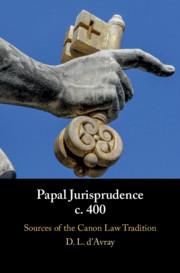Book contents
- Papal Jurisprudence c. 400
- Papal Jurisprudence c. 400
- Copyright page
- Dedication
- Contents
- Acknowledgements
- Abbreviations
- Manuscript Sigla
- 1 Introduction
- 2 The State of Research: Caspar and After
- 3 Texts and Manuscripts
- 4 Rituals and Liturgy
- 5 Status Hierarchy
- 6 Hierarchy of Authority
- 7 Celibacy
- 8 ‘Bigamy’
- 9 Marriage
- 10 Monks and the Secular Clergy
- 11 Heretics: Novatians, Bonosians, and Photinians
- 12 Heretics: In the Shadow of Augustine
- 13 Penance
- Epilogue
- Select Bibliography
- Index
13 - Penance
Published online by Cambridge University Press: 13 December 2019
- Papal Jurisprudence c. 400
- Papal Jurisprudence c. 400
- Copyright page
- Dedication
- Contents
- Acknowledgements
- Abbreviations
- Manuscript Sigla
- 1 Introduction
- 2 The State of Research: Caspar and After
- 3 Texts and Manuscripts
- 4 Rituals and Liturgy
- 5 Status Hierarchy
- 6 Hierarchy of Authority
- 7 Celibacy
- 8 ‘Bigamy’
- 9 Marriage
- 10 Monks and the Secular Clergy
- 11 Heretics: Novatians, Bonosians, and Photinians
- 12 Heretics: In the Shadow of Augustine
- 13 Penance
- Epilogue
- Select Bibliography
- Index
Summary
Penance was a possibility for returning heretics and for other sinners too. As is well known, the penitential system was quite different from what developed subsequently, key features being that the penance was public, marking reinsertion into the community, and that it could be done only once, though anyone could be forgiven at the point of death. Again, practical problems arose: could the clergy do penance? Could one return after penance to professions with a high risk of sin, given the unrepeatability of the ritual? Such practical problems are reflected in the early decretals.
Keywords
- Type
- Chapter
- Information
- Papal Jurisprudence c. 400Sources of the Canon Law Tradition, pp. 276 - 291Publisher: Cambridge University PressPrint publication year: 2019

